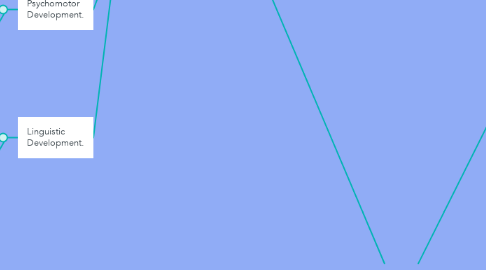
1. 4 to 5 years old
1.1. Cognitive Development.
1.1.1. • They can draw simple geometrical figures • Identify similarities and differences between two objects • They are not able to understand abstractions • They do not understand the concept of time • They are still selfish and independent • They have not developed a logic thinking
1.2. Socio-affective and Personality Development.
1.2.1. • They start being able to control their feelings and behaviours • They can express their own feelings, even though they try to hide them • They start feeling that they belong to a group • Their way to socialize gets better • They need to show all their abilities • They start assuming and following imposed rules
1.3. Psychomotor Development.
1.3.1. • They can kick a ball with strength and precision • They can stand on one foot for more than 10 seconds • They can catch a smaller ball bending their arms • They can run and jump (more than 1m) at the same time • They can clothe and unclothe themselves without help. • They can button and unbutton things
1.4. Linguistic Development.
1.4.1. • By using symbolic play, they develop their mastery of the language. It helps to develop their emotions • The capacities of creativity and simulation are very important for the development of the language • They use sentences from the point of view of other people. They even use the verbs know and questions relate to the acquisition of the knowledge • The socio-dramatic play is very important for the language development as they can assume other roles
2. 5 to 6 years old)
2.1. Cognitive Development
2.1.1. • Attention: they can keep seven minutes doing the same activity • Visual attention: it can go up to fourteen minutes • Memory: they start using conscious strategies to collect information • They start getting the sense of the time • They know the colours • They identify their parts of their body
2.2. Socio-affective and Personality Development
2.2.1. • Real cooperative gameplay • They understand the difference between real and simulated emotions • They hide their emotions intentionally • The conversations about their emotions increase • The friendly relationships emerge • Self-critical awareness and capacity to reflect on their actions and abilities
2.3. Psychomotor Development
2.3.1. • They get better at running, jumping and kicking the ball • They improve their fine motor skills • They can draw following a model • They can write their names • They can draw a person
2.4. Linguistic Development
2.4.1. • Their conversations start being complex • They start learning to take turns • They are curious about new words and they learn very fast from their parents or teachers, media, etc • They can still have some pronunciation problems, but are able to correct them
3. • They accept more and more social rules • They like playing/working with other children (in groups of three or couples) • They start having their own personality • They can feel fear and have nightmares • They feel curiosity about the world • They know other points of view, but they are uncapable to put themselves in somebody else’s shoes
4. 1/2 to 3 years old.
4.1. Cognitive Development & Socio-affective and Personality Development.
4.1.1. • Attention appears • They think symbolically. • Self-defenses. • Character undestable. • Love playing. • they understand.
4.2. Linguistic development
4.2.1. • They understand practically everything they hear • They learn new vocabulary very fast • They can orally express what they like. • If they do not know the words, they invent new words • They make many grammar mistakes. • They can start wit activities which prepare them for reading and writing
4.3. Psychomotor Development
4.3.1. • They can jump 30 cm high • They can stand on one foot for a short period of time (2 years and 6 months) • They can draw horizontal lines and crosses • They can tip-toe • They can catch a ball with open arms • They can show the parts of their body
5. 3 to 4 years old.
5.1. Cognitive Development
5.1.1. • Memory: at 3 years old they start using strategies to remember the information, for example: repetition • They use the symbolic play: imitation games • Selfishness and animism: it gets better at the school
5.2. Socio-affective and Personality Development
5.3. Psychomotor Development
5.3.1. • They can draw circles • Jump down from a certain height with feet together • They can hop • They can clothe and unclothe themselves with help • They can walk sideways and backwards • They can kick a ball more than 10 cm • They can catch a big ball bending their arms
5.4. Linguistic development
5.4.1. • They can understand almost everything in their mother tongue and are able to figure out the meaning of words and expressions in a second or foreign language. • They describe themselves in a simple way
